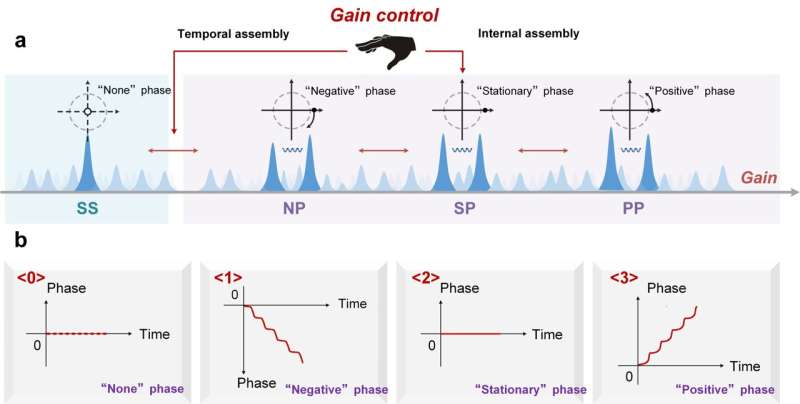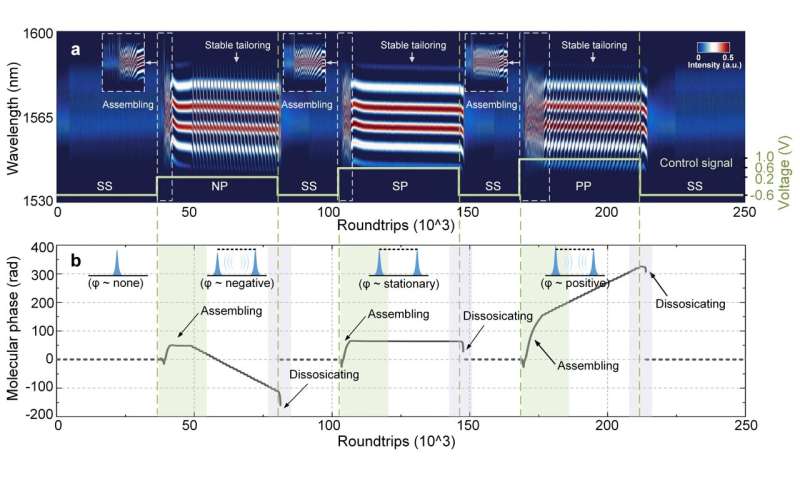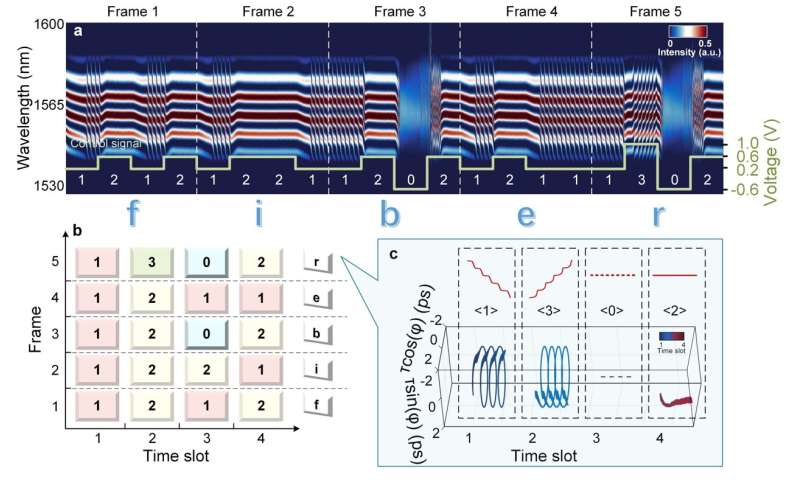This article has been reviewed according to Science X's editorial process and policies. Editors have highlighted the following attributes while ensuring the content's credibility:
fact-checked
peer-reviewed publication
trusted source
proofread
Phase-tailored assembly and encoding of dissipative soliton molecules

Streams of ultrashort light pulses delivered from mode-locked laser resonators stimulate potential applications in ultrafast science and information technology. Here the elementary pulse entity, termed dissipative solitons in contrast to the pure solitons formed in conservative systems, originates from the dual interplays between the dispersion/nonlinearity and gain/loss.
Intriguingly, these ultrashort soliton entities can behave like particles and self-assemble into bound states of complex structures, endowed by the balanced interaction forces. The on-going discovery of internal molecular dynamics, via using the advanced spectral observations, in essence can enrich the manipulation mechanism of soliton molecules.
Intrinsic insights into the mutual interactions reveal the scenarios of energy exchange within the binding structures, which emphasizes the inevitable routes for controlling the assembly of molecular patterns. Viewed from the real-time spectral interferometry, which is regarded as the 'eye' in controllable laser systems, the fringe pattern is modified by external perturbations, generally indicating the beginnings of temporal-separation variations, synthesis and dissociation processes.
With regard to the superiority of the dynamic indicator and the applied foresights, the programmable tailoring of molecular phases is expected to be fuel debate; however, it is barely experimentally achievable for laser resonators.
In a new paper published in Light: Science & Applications, a team of scientists, led by Professor Qizhen Sun from School of Optical and Electronic Information, Huazhong University of Science and Technology, China, and associate Professor Yiyang Luo from College of Optoelectronic Engineering, Chongqing University, China, and co-workers have reported on a new phase-tailored quaternary encoding format based on controllable internal assembly of dissipative soliton molecules.
The soliton assemblies are governed by the gain supply and defined into four regimes with respect to their different internal phase evolutions. They used electronic modulations of gain supply to stimulate the switching between different phase-defined regimes, which is with high fidelity.
-

a, Successive spectral evolution of continuous switching among the four phase-defined regimes. The pump power is modulated by an electronic signal. The insets show magnified views of the assembly processes of the NP, SP and PP soliton pairs, featured by rapid phase evolutions. b, Retrieved evolving molecular phase. The SS regime is denoted by the dotted line. The four phase-defined regimes are easily distinguished. Credit: Yusong Liu, Siyun Huang, Zilong Li, Haoguang Liu, Yixiang Sun, Ran Xia, Lisong Yan, Yiyang Luo, Huanhuan Liu, Gang Xu, Qizhen Sun, Xiahui Tang, Perry Ping Shum -

a, Successive recording of the encoded streams. The pump power is modulated by an electronic signal as embedded in the inset. Each frame is composed of four time slots and represents a single letter. b, Encoded streams are decoded as {1212|1221|1202|1211|1302}, representing a word {f|i|b|e|r}. An exemplary 'r' is portrayed in a 3D interaction space in (c). The trajectory in each time slot agrees well with the corresponding phase-defined regimes. Credit: Yusong Liu, Siyun Huang, Zilong Li, Haoguang Liu, Yixiang Sun, Ran Xia, Lisong Yan, Yiyang Luo, Huanhuan Liu, Gang Xu, Qizhen Sun, Xiahui Tang, Perry Ping Shum
As such, the four regimes allow the constitution of a new phase-tailored quaternary encoding format with an encoding speed of 5 kHz. To validate the availability of this phase-tailored encoding, they exemplified a word "fiber" that is encoded into real-time streams and decoded by retrieving the entire phase evolutions. Such phase-tailored streams are endowed with great robustness and possess high antijamming capability. These scientists summarize the operational principle of the phase tailoring approach:
"Inspired by advanced applications of ultrafast optics in all-optical storage and optical computations, we develop an ultrafast laser-based manipulation system for the programmable tailoring of the molecular phase by implementing precise electronic modulations of the gain supply."
"The energy exchange within the molecular structures is manipulated to stimulate the deterministic harnessing of the phase-tailored soliton assemblies. Self-assembled soliton molecules are tailored into four phase-defined regimes, thus constituting the phase-tailored quaternary encoding format."
"In particular, this direct electronic modulation can be improved by upgrading the electronic modulation signals to avoid the common recoil voltage and unstable voltage. The well-set voltages for these four phase-defined regimes can optimize the hysteresis of the continuous switching and the fidelity of the phase-tailored encoding."
"For increasing the speed of the quaternary encoding, faster phase-evolving velocities can be taken into account. Thus, we believe that the electronic modulation of the gain supply is considered as a direct and efficient way to realize the programmable tailoring of the molecular phase of the dissipative soliton molecules, and desirable for the applications in practical occasions," they added.
"We consider two major avenues for the future investigations. One is to introduce the joint temporal-spectral analysis of the time-stretch dispersive Fourier transform and the time-lens measurements. The real-time full-field characterization can provide new insights into the internal motions, especially for the complex molecular patterns."
"'Hands' can help control the laser parameters such as the gain, dissipation, dispersion, nonlinearity and polarization to drive the artificial manipulation. The released degrees of freedom of harnessing and the technical advances are expected to fuel this research topic and extend the application scenarios in the near future," the scientists said.
More information: Yusong Liu et al, Phase-tailored assembly and encoding of dissipative soliton molecules, Light: Science & Applications (2023). DOI: 10.1038/s41377-023-01170-x
Journal information: Light: Science & Applications
Provided by Chinese Academy of Sciences



















